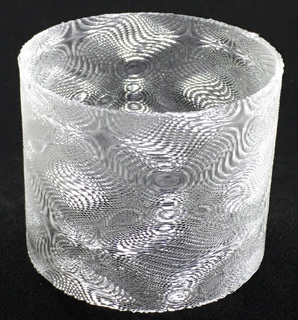3D printing video on naturally fluctuated patterns submitted to YouTube
A video on "Randomized shape creation with fluctuating 3D printing process" was submitted to YouTube. The title is "Creating naturally-fluctuated patterns using a 3D printer".
A video on "Randomized shape creation with fluctuating 3D printing process" was submitted to YouTube. The title is "Creating naturally-fluctuated patterns using a 3D printer".
The printing process of an Olympic symbol using "natural-direction 3D printing" was taken by camcorder, and the resulting videos were submitted to YouTube. Because it takes about 34 minutes to print it, two versions were submitted: 1x digest video and 8 x whole video.
By using a 3D printer in unusual way, interesting randomized "CA-like" patterns are generated (see this video). Sparse and more fluctuated patterns are generated when extruded less filament, and dense and more regular patterns are generated when extruded more filament.
By using a 3D printer in unusual way, interesting randomized "CA-like" patterns are generated (see this video). When the grids are relatively sparse, filament sometimes stacks regularly and sometimes stacks randomly.
I attended the SFF Symposium of this year and found that there were several presentations that focused on Printrbot, a 3D printer make. Printrbot was the first 3D printer that I built up from a kit. I found several design defects that causes my much labor. When I see what they have done since then, they seem to be mindless of users convenience. However, Printrbot seems to be still popular among much increased types of 3D printers. I do not understand the reason why so.
All3DP, a Web site that nicely summarizes various 3D-printing related topics, presented 3D printing trouble shooting: 34 common problems. The description of countermeasure is not necessarily very convenient. However, there are several interesting photos in the described cases.
 For more than a year, I have investigated patterns generated by synthesizing three types of waves by helical 3d printing.
Because waves are synthesized by linear models by this method, I thought no unexpected patterns are generated. However, very recently I found that unexpected complex patterns are generated by using very fine deformation waves.
For more than a year, I have investigated patterns generated by synthesizing three types of waves by helical 3d printing.
Because waves are synthesized by linear models by this method, I thought no unexpected patterns are generated. However, very recently I found that unexpected complex patterns are generated by using very fine deformation waves.
When amount of filament is decreased in 3D printing (FFF), striped patterns and various patterns with fine holes are generated. I wrote and showed such patterns in my blog in Japanese and wrote several papers on this issue. Researchers in MIT applied such patterns, which people usually try to avoid, to clothes. I wanted to develop practical applications of such patterns, but I could not find one.
By using the helical 3D printing method, a cylinder with screws can be created by a single roll of filament. Screws are formed both on outside and inside of the cylinder. So, if forming multiple cylinders with close radiuses, they can be screwed in each other. I took some photos of such nested screws.

Objects printed by using the new direction-specified design and printing technology are sold in Dasyn Yahoo! Japan shop.